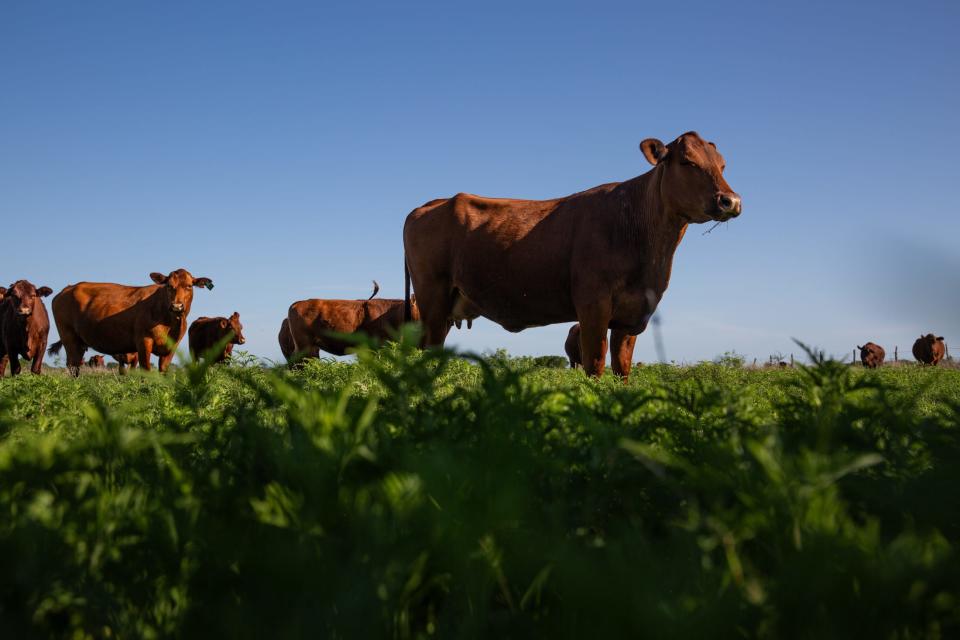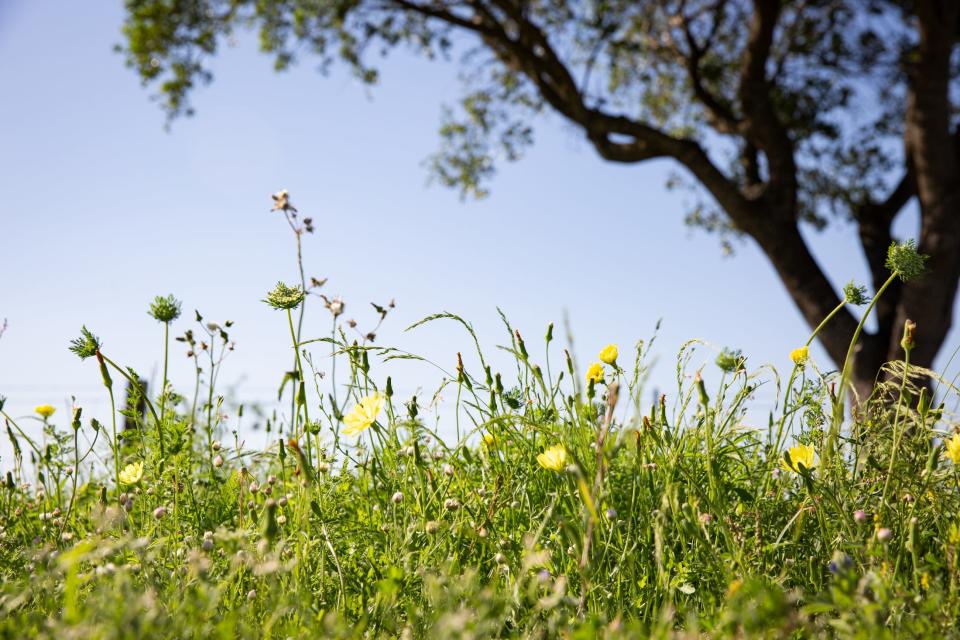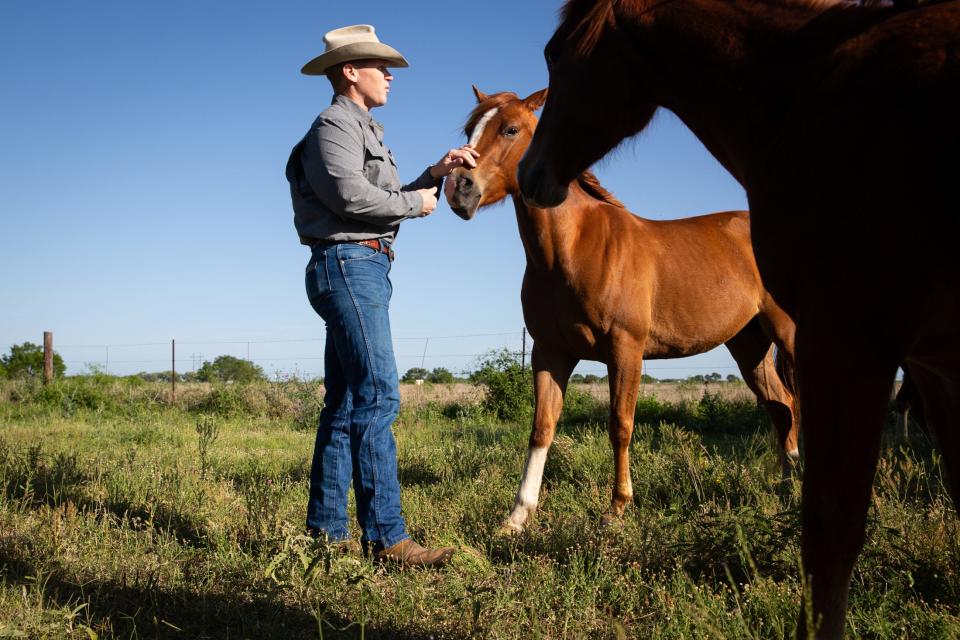King Ranch heir focusing on restoring soil health and stewardship
- Oops!Something went wrong.Please try again later.
This story has been updated to reflect the following corrections:
Santa Gertrudis Creek is the name of the creek on which King Ranch was founded. An article on Page 1A Sunday misspelled the creek's name.
Overproduction and intensive grazing have been an aspect of some Texas ranches in the last two centuries. An article on Page 1A Sunday misstated that these two practices have characterized Texas ranching for the last 200 years.
James Clement III is a descendant and shareholder of King Ranch. An article on Page 1A Sunday misstated that he is an inheritor.
Beggs Cattle Company is the name of James Clement III's mother's family ranch. An article on Page 1A Sunday misspelled the ranch's name.
Planting bluestem grass into resting pasture fields to control erosion and preserve native trees such as mesquite is a ranching practice in Texas. An article on Page 1A Sunday misstates that James Clement III currently applies this practice.
The South Texas region that encompasses the four divisions of the historic King Ranch, established on the banks of the Santa Gertrudes Creek by Richard King in 1853, is rich in wildlife and natural resources that successive generations of ranchers view as an opportunity to improve soil health and environment through regenerative agriculture.
This term can have different meanings, but for King Ranch inheritor James Clement III, who owns a ranch in Kingsville, it’s about being a good environmental steward and restoring soil balance by resting the land.
He and his wife, Paige, are carrying on the tradition of his family’s cattle and ranching business while implementing a set of practices designed to counteract the effects of overproduction and intensive grazing that have characterized ranching in Texas for the last 200 years.
“I want to make soil health the story of South Texas,” he said. “We’re trying to keep the ranch as open grassland to get it back to the way it was, before the grasses were disturbed. If you’re a good steward, the soil will be better and the land will be better, maintain sustainability and improve productivity, and the less will have to go into inputs.”
Heritage ranching with better management and production
Clement III raises Santa Gertrudis cattle, a hardy breed resistant to heat, humidity and unfavorable environments, that was produced under the leadership of Robert Kleberg Jr. and Dick Kleberg Sr. on the ranch in the early 20th Century, and American Red, a cross between Santa Gertrudis and Red Angus. The ranch’s quarter horses are descended from Old Sorrel, one of the foundation sires of the American Quarter Horse breed, crossed with North Texas’ Biggs Cattle Company cattle horse lines. They graze full-time in pastures with his cattle.

His interest in the soil carbon business is two-fold: A pasture-based system benefits the cattle that forage on the land, who in turn contribute to sequestering carbon underground. Focusing on soil health can inspire and recruit the next generation of ranchers who want to raise cattle and tend the land differently than their predecessors, or who are interested in ranch management.
“This soil carbon industry could change and support the way people manage land in a huge way,” Clement III said.
In South Texas, where plentiful rainfall feeds enough of a growth season that the soil can be covered in grass for most of the season, stewardship can be as simple as ensuring the land is not overgrazed, which increases productivity for livestock, wildlife and fauna on the native range. It also entails letting wildflowers grow, planting bluestem grass in resting pasture fields for erosion control and preserving mesquite.

Mesquite grows plentifully in a forested area of the ranch, watered by a portion of the Ebanito Creek that snakes through the area. The trees produce beans that were a staple food for the mustangs that roamed the coastal grasslands and prairie of the Wild Horse Desert before Spanish settlers arrived with cattle. Afterward, they traveled in the bellies of horses that drove the cattle to northern cities and railheads to be planted along the way.
However, much of the mesquite and huisache that were on King Ranch in the 1880s were cleared to develop and consolidate the ranch and increase breed improvement of horses and cattle.
Allowing the land to restore itself by refraining from clearing brush, as well as letting native trees, thickets and shrubs grow, can attract deer, quail, pygmy owls and other wildlife to the countryside.
Ranchers and farmers have long known the benefits of capturing carbon in their fields to increase biodiversity, improve water quality and store important nutrients such as nitrogen. Texas, with 129 million acres of agricultural land, has more farms and ranches than any other state and great potential to store carbon, but it is also losing farmland faster than any other state, according to the Nature Conservancy.
Scientists know that despite the ability of soil-based carbon sequestration, more must be done to take carbon out of the atmosphere and reduce greenhouse gas emissions.
Programs such as the U.S. Department of Agriculture’s Conservation Reserve Program (CRP), which pays farmers to remove environmentally sensitive land from production, incentivizes a wide variety of farmers and landowners to enroll their acreage and focus on management and production practices and keep their ranches in family hands.
Clement III’s interest in soil health began about 10 years ago, eventually leading him to sign up to sell carbon credits with Grassroots Carbon, a Texas-based company that works with corporate industry buyers to pay ranchers for their carbon storage.
Clement III became so engaged in the process and its potential to help ranchers preserve the land and legacy of their family histories that he went to work for an aligned business, EarthOptics, a soil data measurement and mapping company that measures, reports, verifies and certifies the amount of carbon stored in soil, which Grassroots Carbon issues as credits under the Regenerative Standard.
Earning Credits by Capturing Carbon Emissions
Today, he earns carbon removal credits through the 15-year Carbon Storage Program with Grassroots Carbon for every metric ton of carbon stored in the soil, while EarthOptics provides the meter-deep soil samples that reach the mineral layers of soil to be analyzed in a lab to determine how much carbon is being stored through regenerative land practices.
The accurate, low-cost methodology provides an economical way for ranchers to join the carbon economy, said Todd Martin, founder and chief commercial officer of EarthOptics.
EarthOptics also applies sensor scanning to take measurements of total field carbon storage during a season, resulting in a more accurate picture of ranchers’ soil carbon profile than would be given through remote sensoring and satellite imagery, he said.
This key partnership between the ranching community and top-tier companies has financed a commitment to regenerative ranching that, year after year, can generate a higher price that enables ranchers to maintain and sustain ownership of the ranch, said Brad Tipper, CEO of Grassroots Carbon.
“At Grassroots Carbon, we pay ranchers to adopt and maintain regenerative practices that improve soil health, making it a viable way for ranchers to enhance day-to-day productivity and gain additional income through the high-quality soil carbon credits they generate,” he said. “It provides limitless opportunities for the rancher to benefit by learning and knowing their land and leveraging their great resources to optimize the grasses’ capacity to draw down carbon.”

Clement III is now the senior vice president and general manager of Grass and Rangeland with EarthOptics, introducing ranchers to the new technology of mapping and quantifying the health and carbon capture capabilities of their soil to make better land decisions and add revenue.
As he looks to the future, he would like to establish a weekly or bi-weekly rotation for cattle that would involve dividing the vast ranch acreage into smaller paddocks or managed pastures with electric fencing, allowing them to graze for two-week intervals before resting. This method would reduce grazing to a few months annually so that the land could rest for most of the year while continuing with current practices such as flash grazing to manage invasive species.
Knowing the capacity of soil and grass to draw down atmospheric carbon dioxide into the soil, he will continue working with grazing management specialists and ranch partners at Texas A&M to establish a ranch management ecosystem that would capture larger quantities of carbon and, referring to the Savory Institute model, “turn deserts back into grassland.”
This article originally appeared on Corpus Christi Caller Times: King Ranch practicing regenerative agriculture on South Texas ranch

